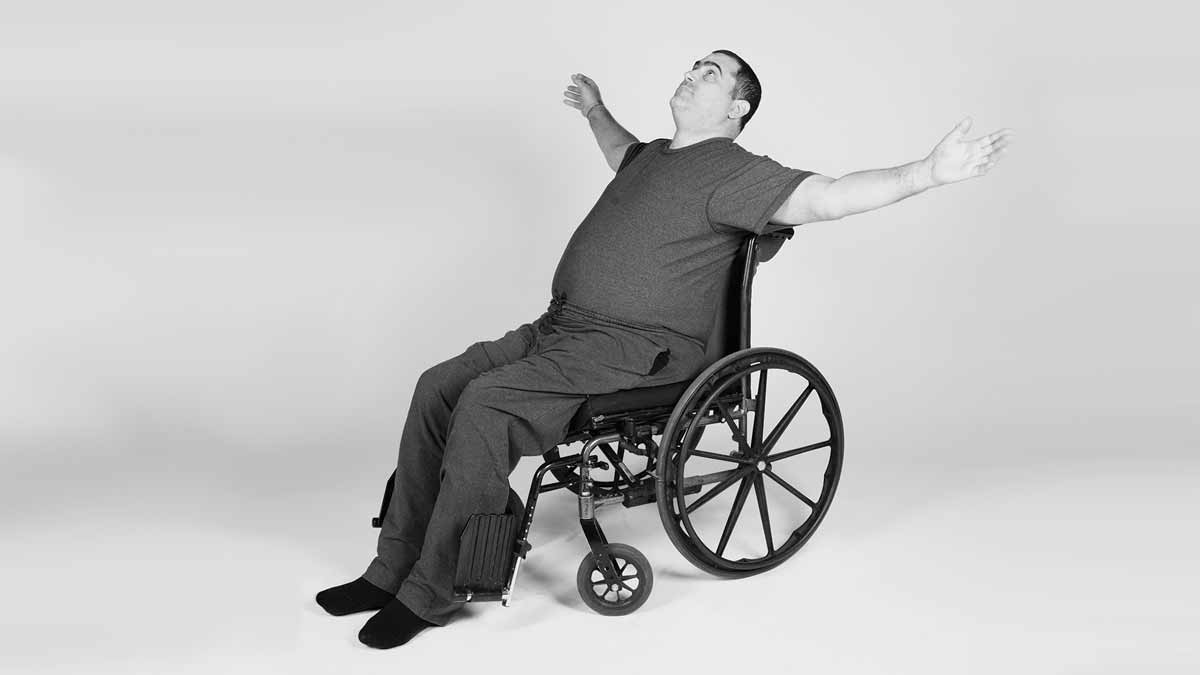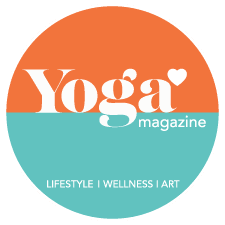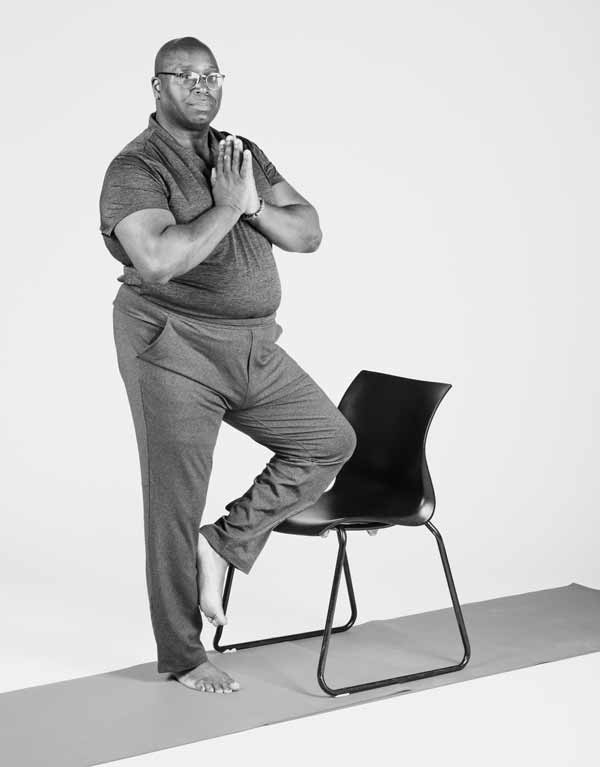Accessible Yoga
Photos: Sarit Z. Rogers

Jivana Heyman, founder of non-profit organization Accessible Yoga, gives readers a gentle nudge to step into a safe yoga practice that fits the needs of any person in his book, Accessible Yoga: Poses and Practices for Every Body. With compassion and years of experience, we are guided into an accessible yoga practice, literally for every body. Yoga Editor for NY YOGA LIFE magazine, Lauren Cap had an opportunity to chat with Jivana right before the pandemic in early 2020, and shares her interview below.
I first want to thank you for creating Accessible Yoga to make yoga available to all communities with various physical abilities. It’s important to have information like this at our fingertips to remind everyone that yoga is most importantly about feeling good, not looking good.
Thank you for your interest in Accessible Yoga, and for your awareness that yoga is really about feeling good, not about how you look or what kind of poses you can do. It’s unfortunate that the image of yoga in the media is so limiting when the benefits of yoga are so powerful and are available for everyone. In fact, I often think of how it’s those of us who are struggling the most who can really benefit from yoga.
I came to yoga to help me deal with the pain and stress in my life, and I’m so grateful for how yoga has given me tools to help me with the challenges of being human. I feel like I owe a debt of gratitude to give back in some way, and my mission is to challenge those limited ideas we hold on to about what yoga is and how it works.
The most important thing for people to understand about yoga is that it is primarily a mental practice – working with the mind to reduce stress and connect with the essence of who we are. I often say, “Yoga isn’t about having a flexible body, it’s about having a flexible mind.” With that deeper understanding of the practice, it’s easy to find ways to make all the practices of yoga accessible, whether we’re talking about the poses, breathing practices, relaxation techniques or meditation.
The use of pose orientation in this book is very creative as we are able to maintain the elements of the traditional practice while offering an accessible way to receive the healing benefits of yoga. How do you empower practitioners to look beyond their physical limitations and feel confident in their Accessible Yoga practice?
I think knowledge is power, and one of the challenges in yoga is that there’s this feeling that the classical poses can’t be adapted or somehow they lose their power. Most of the poses we’re practicing these days evolved over the past few hundred years. It’s really the philosophy, meditation and breathing practices that are most ancient. The more people understand the underlying benefits of individual poses, the more they can find those benefits in different variations. That’s the way I’ve organized my book – trying to help people look beyond the superficial appearance of a pose and consider why they’re doing it. The “why” of a practice is the key to adaptation and accessibility.
What are some challenges you’ve witnessed from students who may be reluctant to a practice that doesn’t resemble what they see on social media or magazines? How do you work with your students to identify those needs to create a safe space of acceptance?
Safety and acceptance are the two most important elements of a yoga class. I want people to feel like they belong in the space, and that they will be safe – physically and emotionally. In order to do so, I often directly address the misrepresentation of yoga in the media. I try to teach my students about what yoga is – working with the mind to connect with the heart.
The main challenge that comes out of the misrepresentation of yoga within yoga classes is the idea that more is better. I constantly see students straining and potentially injuring themselves. It can take experience to learn about how far to go into poses and how long to hold them. I worry that with the competitive nature of our Western culture, many people are getting hurt in yoga. I also worry about the emotional suffering that people experience in yoga classes – feelings of not being good enough, or that they don’t belong.
There’s a common phrase, “The students are our teachers.” Along with your extensive training and experience, do many of these sequences and alternative practices come from practitioner feedback?
Yes, pretty much everything I teach comes from collaborating with my students and from other teachers who have inspired me. A key element of accessible yoga is collaboration, which is based on the idea of seeing the student as your equal and lifting them up. The traditional teacher/student hierarchy can be disempowering and lead to many problems, including much of the abuse we are seeing in the yoga world.
Collaboration is a key element in my teaching because it asks the student to step into their inner wisdom and sharpen their awareness. It can help them take on their yoga practice in a more profound way. In many ways, my goal is to make the students independent yoga practitioners who aren’t reliant on me. The more they feel that they have their own practice the more yoga will become an important part of their lives.
How has your personal practice changed over the years from when you first started?
I’ve been practicing yoga intently since I was in my early twenties, and now I’m in my early fifties, so a lot has changed. As my body ages, I try to find a practice that is supportive of my wellbeing in every way. When I was younger I would push myself into some of the more gymnastic poses, but after a lot of injuries, I’ve finally learned my lesson.
Nowadays, I don’t plan what I’m going to do when I get on the mat. I like to take a moment to notice how I’m feeling and consider what will be most supportive of my body and my mind in the moment. In fact, my mental state may be the most compelling part of my daily practice. I ask myself, do I need a more inward, slow, gentle practice with restorative poses and longer pranayama? Or do I need a faster, fun practice with music? Is there a part of my body that needs to be protected, strengthened, or stretched? Each day is a new adventure.
I realize that for a new practitioner that might be too much to take on. In the beginning it’s fine to do the same practice every day and notice how it feels. Gaining sensitivity to what’s happening inside your body. Introspection is an essential skill that comes with practice. Also trying out all different styles is a great way to learn about all the different tools that yoga offers.
What has surprised you the most since founding Accessible Yoga?
I’ve been most surprised by the incredible reaction I’ve gotten, and how much this work resonates with so many people who love yoga deeply. A big part of the mission of Accessible Yoga, the non-profit, is to support yoga teachers who are making yoga accessible. I’ve been amazed by the work that yoga teachers are doing all over the world. These are teachers who are serving day after day to bring yoga to communities that have been disempowered or underserved. They are often serving without recognition, and sometimes without even getting paid!
Wherever I travel, I meet yoga practitioners and teachers who have found the power of yoga and are sharing it with others. Their dedication and service is what propels me to continue to work for greater understanding and to break down barriers to access. All the issues that limit access to wellness also limit access to yoga – racism, sexism, ableism, homophobia, transphobia, etc., are all issues in the yoga world.
Physical adjustments in class has been a hot topic recently. To quote you, “Ongoing consent means that just because a student gives you consent at one point in class doesn’t mean that you have consent to touch at another time…Ongoing consent means that we open up a dialogue with our students during class…you can create an environment where declining touch is accepted and even celebrated, where students are learning to connect with themselves and speak up for what they need.” Do you have any additional comments on this topic?
It’s very important that we have more discussions in the yoga community about the lack of consent for touch that is happening in a lot of classes. Most of us weren’t trained in how to gain consent from our students, and we assume that hands-on adjustments are what the students want. I think we’re just starting to address this issue as a community, and I’m sure we’ll see more policy changes in the coming years to create more clarity around this topic.
The first thing we need is a clear scope of practice for yoga teachers, as well as a thorough code of conduct. We currently don’t have either, and it means that many yoga teachers are offering touch, adjustments and other practices without appropriate training. It also means that as a community we don’t have clear guidelines to follow to keep students safe.
Ironically, the real power of yoga resides in its ability to calm the mind and allow us to turn inward. I think we need to turn to the heart of yoga, which is already accessible, in order to make the practice safer and more effective for all our students.
Learn more: jivanaheyman.com

